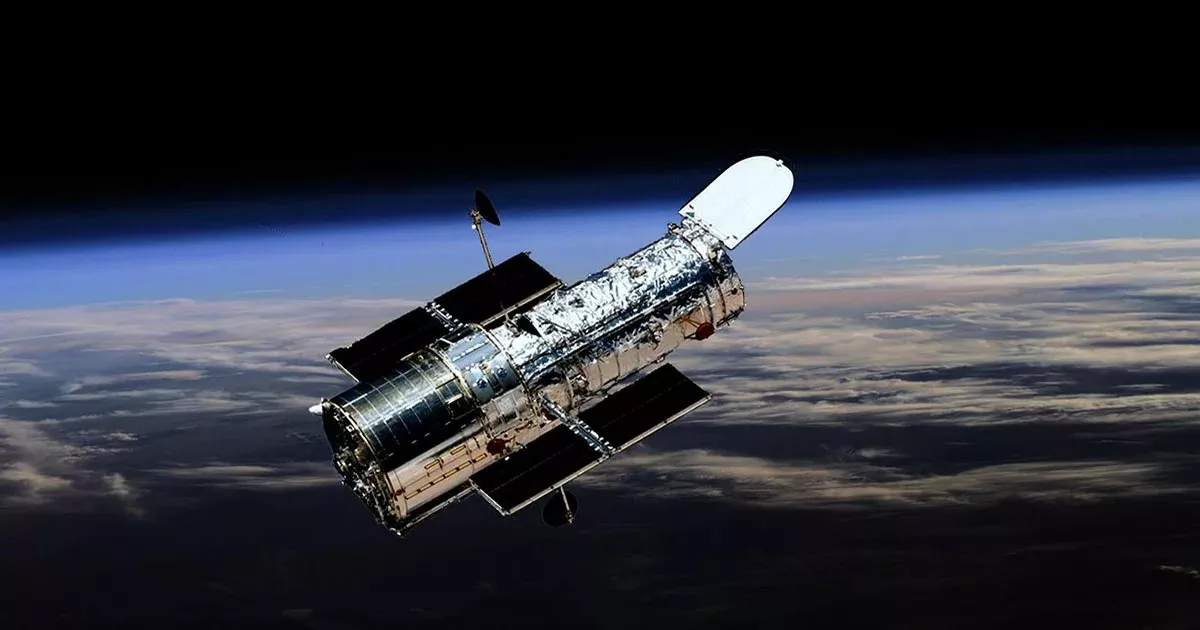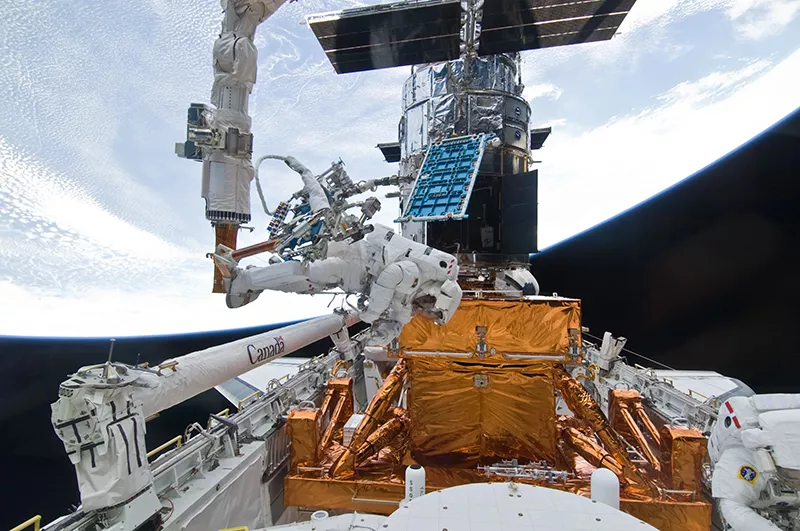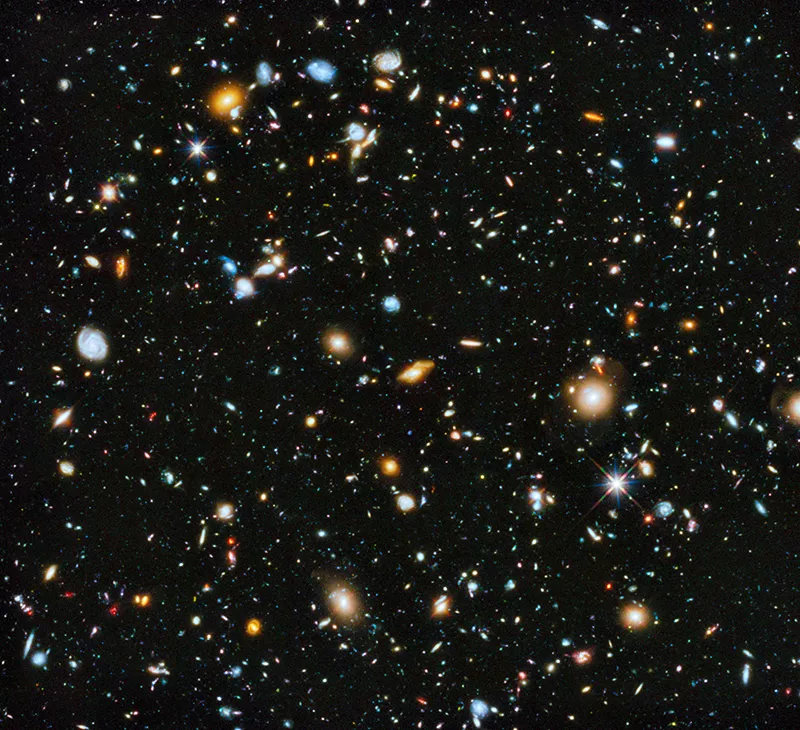

In 1946, Lyman Spitzer proposed a Large Space Telescope in a paper he published while at Yale. Keep in mind there were zero artificial satellites in space at the time. He talked about the advantages of having a telescope outside of the atmosphere. This was all fantasy at the time. The technology just wasn’t there. Hubble had a long way to go.
That all changed in 1957 when Russia launched Sputnik 1 into orbit. This resulted in the U.S. government signing the Space Act in 1958, creating NASA. In 1969 the National Academy of Sciences published another report on the advantages of space telescopes. The idea then started to gain more traction. In 1974, a group of astrophysicists and engineers held the first of many meetings. They came up with a concept for what a space telescope would look like, technical requirements, and even a budget.
In 1977, Congress approved the budget, and work began on designing the space telescope.
In 1978, work began on the 8-foot primary mirror. A year later, astronauts began training for servicing missions. The original design of the telescope was to be serviced frequently. In 1983, the telescope was dubbed Hubble after Astronomer Edwin Hubble. He was the first to prove that there were other galaxies in the cosmos. The 1986 Challenger disaster pushed the launch of telescope back until shuttle launches could continue.
Finally, on April 24th, 1990, The new telescope took off inside the space shuttle Discovery. A day later, it was deployed using the SRMS arms. In May, the first image returned and was 50% sharper than ground-based telescopes.
In June 1990, Nasa first announced the imperfection in the primary mirror that affected its clarity. It was still able to conduct science, however. In December 1993, Hubble received its first servicing mission. On the mission, astronauts installed a new wide-field camera, and Hubble got a pair of glasses in the form of COSTAR. A year later, the telescope discovered black holes, which were mere theories until then.
There have been five missions total to service Hubble, the last being in 2009. With the space shuttle’s retirement, we currently need a way to perform further servicing missions.
Despite the excitement and high expectations surrounding the Hubble Space Telescope's deployment, a significant flaw soon became apparent. In June 1990, just a couple of months after its launch, NASA announced that the primary mirror had an imperfection. This imperfection, known as spherical aberration, meant that the mirror had been polished to the wrong shape, causing the light to focus improperly.

As a result, the images returned were blurry and lacked the clarity that was expected from such a groundbreaking instrument. The flaw was a mere 2.2 microns, thinner than a human hair, but it dramatically affected the telescope's performance. However, the scientific community did not despair. In December 1993, during Hubble's first servicing mission, astronauts undertook the monumental task of correcting this defect.
They installed the Corrective Optics Space Telescope Axial Replacement (COSTAR) along with a new Wide Field and Planetary Camera. This innovative solution acted like a pair of corrective glasses, compensating for the mirror's flaw and restoring the telescope's vision. The success of this mission transformed Hubble into the powerful observational tool it was meant to be, enabling it to capture stunning images and make revolutionary discoveries.
Amidst the countless components that make the Hubble Space Telescope a marvel of modern engineering, its gyroscopes play a crucial role. These tiny, unassuming devices are the heartbeat of Hubble, ensuring its stability as it captures images from the farthest reaches of the universe. Over the years, Hubble's gyroscopes have faced wear and tear, necessitating their replacement during servicing missions. Each mission to replace these gyroscopes was a delicate dance in the weightless expanse of space, where astronauts braved the void to give Hubble a new lease on life. Their efforts ensured that Hubble could continue its celestial observations with precision, bringing the cosmos into sharp focus for all of humanity.
In the cold, dark expanse of space, the Hubble Space Telescope relies on the power of the sun. Its solar panels, like wings outstretched, capture the sun's energy to fuel its journey through the stars. Over time, these panels have been upgraded, each new set more efficient than the last. During one such upgrade, astronauts worked tirelessly to unfurl the new panels, ensuring Hubble could continue to draw power from the sun's rays. This solar lifeline has allowed Hubble to operate far longer than originally anticipated, its panels glinting in the light as it orbits Earth, ever vigilant, ever exploring.
Hubble has opened our eyes and minds to what the cosmos consists of. It has turned theories into facts. Here are just some of the discoveries the telescope has unveiled.

In a daring experiment, astronomers pointed the Hubble Space Telescope at what appeared to be an empty patch of sky, no larger than a grain of sand held at arm's length. Over the course of ten days, Hubble's gaze remained fixed, capturing faint glimmers from the depths of space. The result was the Hubble Deep Field, an image teeming with thousands of galaxies, each a cosmic city of stars, planets, and potentially life. This image, followed by the even more profound Ultra-Deep Field, allowed humanity to peer back in time, revealing galaxies as they existed billions of years ago. Hubble's deep field images are a testament to the power of curiosity and the profound revelations that await us in the silent, infinite darkness.
As Hubble gazed into the heavens, it began to uncover new worlds orbiting distant stars—exoplanets. By observing the subtle dimming of starlight as planets passed in front of their suns, Hubble provided some of the first detailed glimpses into these alien worlds. Not just content with finding these planets, Hubble's keen eye examined their atmospheres, detecting water vapor, methane, and other signs that hint at the conditions on these distant orbs. Each discovery added a new chapter to the story of our universe, suggesting that our solar system might be just one of many in a galaxy teeming with planetary systems.
One of the most groundbreaking revelations facilitated by Hubble was the discovery of dark energy, a mysterious force driving the accelerated expansion of the universe. By meticulously observing distant supernovae, Hubble helped astronomers detect this enigmatic energy that makes up about 68% of the universe. This discovery was akin to unveiling a new, unseen character in the cosmic narrative, one that dramatically altered our understanding of the universe's fate. Dark energy's invisible hand shapes the cosmos, and Hubble's observations continue to guide scientists as they unravel the mysteries of this elusive force.
Hubble's mission has always extended beyond the realm of science; it has been a bridge between the cosmos and the public. The breathtaking images captured by Hubble have been made publicly accessible, allowing people around the world to witness the splendor of the universe firsthand. These images have adorned countless textbooks, websites, and even art galleries, igniting imaginations and inspiring future generations of astronomers and scientists. Hubble's legacy is not just in the data it has collected, but in the minds it has opened to the wonders of space.
In classrooms around the world, Hubble's discoveries have become a cornerstone of science education. Educational programs and public outreach initiatives have leveraged Hubble's findings to teach students about astronomy, physics, and the vastness of the universe. Through interactive programs, virtual tours, and stunning visual materials, Hubble has been a source of inspiration and a catalyst for curiosity. It has encouraged young minds to look up at the night sky with a sense of wonder, dreaming of the mysteries yet to be uncovered.
Hubble has been in service for over 30 years and is still kicking. However, the telescope’s orbit will decay to the point that sometime in the 2030s, it will fall back to earth in a controlled descent that will cause the station to fall into the southern Pacific Ocean. In September 2022, NASA and SpaceX signed an agreement to perform a study into a possible Dragon mission to boost the telescope’s orbit. Possibly expanding the life of the telescope for decades to come. Though nothing is set in stone.
With the JWST coming online in 2022, Hubble has remained relevant. The two telescopes have been working in concert. Hubble finds targets, and JWST is used to examine them further. The Spitzer telescope has also been acting as a scout for JWST. With the three telescopes working together, we should see some fantastic images in the coming years.